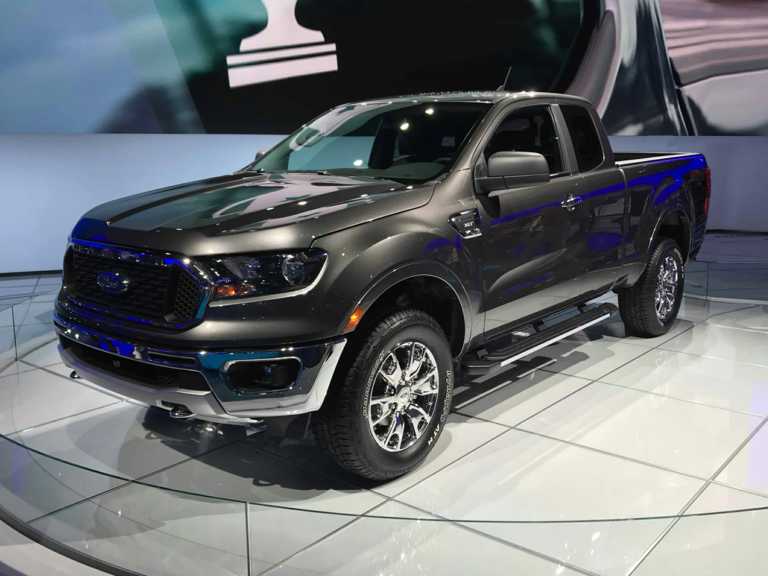The 2020 Ford Ranger features a 2.3-liter four-cylinder engine with quick acceleration. Even though the engine is only a four-cylinder, it is turbocharged, which gives it more power. The Ranger does well when hauling a load or towing a trailer.
What are the specs of the Ford Ranger 2.3-liter engine?
The Ford Ranger 2.3-liter engine features an aluminum block and heads and uses the direct injection fuel system. The inline four-cylinder engine is 138.2 cubic inches and is turbocharged.

The Ford 2.3-liter engine makes between 280 and 350 horsepower, depending on the application. The peak horsepower comes in between 5,500 rpm and 5,600 rpm, depending on the application (Ranger, Mustang, etc.).
The 2.3-liter engine makes 305 to 350 lb.-ft. of torque, again, depending on the application. Regardless of the application, the engine’s compression ratio is 9.5:1.
The change in horsepower and torque comes in because of the weight difference of different vehicles. Even the three Ranger models could have different horsepower if the weight of additional features is significant enough.
History of the Ford Ranger 2.3-Liter Engine
The 2.3-liter EcoBoost engine was introduced in 2015, along with the second generation of the 2.0-liter EcoBoost engine. The first vehicle that had the 2.3-liter was the 2015 Lincoln MKC crossover. It wasn’t until a year later that Ford dropped it in the Explorer and the Focus RS.
The engine made 350 horses in the Focus RS. Then, Ford dropped it into the Mustang, where it made 310 horsepower and 320 lb.-ft. of torque.
The 2.3-liter EcoBoost has the same size block as the 2.0-liter EcoBoost, but because of the higher horsepower and what Ford did to it to get the horsepower, the 2.3-liter has some extra fortification.
The block is high-pressure die-cast aluminum. It features larger cooling and oil passages, plus a structural ladder frame around the cylinders. The structural ladder frame has integrated main bearings to tie it all together.
Ford achieved the increased displacement by installing a 4340 steel crank with a 94-mm stroke. The 2.0-liter EcoBoost has just 83.1-mm stroke. The connecting rods are forged steel and are shorter than the rods in the 2.0-liter EcoBoost.
Finally, Ford added high-strength pistons decked out with fully floating pins and steel piston ring carriers. The low-friction skirt coating and fewer drainage holes allow for better lubrication in the cylinder.
Special oil jets inside the engine block constantly spray oil on the bottom part of the cylinders to keep the cylinder cooled.
Which Models Feature the Ford Ranger 2.3-Liter Engine?
You’ll find the 2.3-liter EcoBoost engine in all three Ranger trim levels: the XL, XLT, and the Lariat. You’ll also find it in Ford’s Focus models, Lincolns, and Mustangs.
People Also Ask
How much horsepower does a 2.3-liter EcoBoost engine produce?
The 2.3-liter EcoBoost engine makes between 280 and 350 horsepower and 310 to 320 lb.-ft. of torque, depending on which vehicle it is in. The turbocharger, direct injection, and the stroked bottom end all contribute to the horsepower and torque ratings.
Generally, the lighter the vehicle, the more horsepower and torque it will have. The type of transmission Ford decides to pair with the engine also makes a difference. And, the overall weight of the vehicle makes a difference.
If you were to put the 2.3-liter EcoBoost engine in two vehicles that weigh the same and have the same transmission, but put a person who weighs 100 pounds in one and a person who weighs 200 pounds in the other, the vehicle with the 100-pound person will win by about 1/10 of a second.
How many cylinders does a 2.3-liter EcoBoost engine have?
The 2.3-liter EcoBoost engine has four cylinders. Ford uses it in the Ford Ranger, Mustang, Lincoln, and even in some of the F-150 models.
Where is the 2.3-liter EcoBoost engine made?
The 2.3-liter EcoBoost engine is made at the Cleveland engine plant in Ohio. Some of the EcoBoost engines, including the 2.0-liter, might still be made in Valencia, Spain.
Is the 2.3-liter EcoBoost a good engine?
The engine is a high-performance engine that is tuned for those who like to race. The more pressure you put on an engine block by getting more horsepower and torque, the easier it is for things to break. Thus, the reliability of the EcoBoost components is close to the limits.
How long do EcoBoost engines last?
Like any other engine, EcoBoost engine could last well over 200,000 miles before you need to freshen it up – as long as you routinely do the maintenance on the engine and don’t beat it up too hard.
Does the EcoBoost need premium gas?
You can run it on 87 octane, but the engine boost declines by 1.9 psi. Although using premium fuel only nets you a half-mile per gallon difference, it does give you better performance. Turbochargers prefer the higher grade.
What does EcoBoost mean?
EcoBoost is Ford’s name for its lineup of turbocharged engines. They use direct fuel injection and are designed to get more horsepower and torque out of smaller engines.